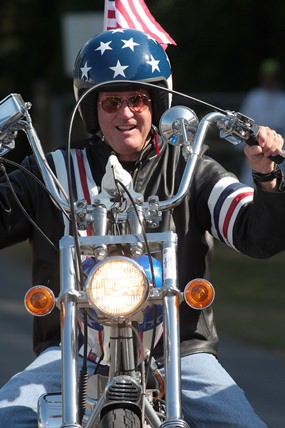Last week I used the photo I am using again this week, because it is such a good example of making your subject the “hero”. This shot was taken by an amateur in the UK and he could see that he had a great subject with Peter Fonda on the chopper from the 1969 movie Easy Rider which starred Fonda, Dennis Hopper and Jack Nicholson.
The motorcycles alone would be a great subject, and one was even mentioned in litigation between Fonda and Hopper. Fonda claimed that Hopper sold a knockoff of the Captain America motorcycle Mr. Hopper rode in the film for $9,000 because “he needed money for drugs.” (It was settled out of court.) You can read more at http://observer.com/1998/03/easy-riders-feud-as-dennis-hopper-cheers-peter-fondas-nonoscar/#ixzz3BlPCGSFq

However, Peter Fonda is also a great subject, and the photographer had to make a choice. Fonda, motorcycle or both together?
For impact, I believe he made the best decision. The “hero” was Fonda, and the motorcycle allowed the viewer to place the connection to the movie. Having chosen the hero, he moved in close making Fonda the principal subject and almost filling the frame; however, the motorcycle, recognizable as a chopper, was just a prop.
All good photographs follow the rules of good composition. The best known one of these is the Rule of Thirds, where you position the subject of the photo (that’s the hero) at the intersection of one third from the top or bottom of the viewfinder and one third in from the right or left side of the viewfinder.
By just placing your subject off-center immediately drags your shot out of the “ordinary” basket. The technocrats called this the “Rule of Thirds”, but even just try putting the subjects off-center. While still on the Rule of Thirds, don’t have the horizon slap bang in the center of the picture either. Put it one third from the top or one third from the bottom. As a rough rule of thumb, if the sky is interesting put more of it in the picture, but if it is featureless blue or grey include less of it. Simple!
With some cameras where you can make a grid pattern on the viewing screen from the menu, such as on the DMC FZ series Lumix, it makes it even easier to position the subject. With the vertical lines, you will soon see if you have the subject vertical, and for horizontal subjects incorporating the horizon, you can also make sure it is level. This composition is something you can do in the camera as you take the shot. It does mean that you look critically through the viewfinder and position the subject correctly.
Now, that is not the only item you should think about with your photographs, though it is obviously a good start! The next item is cropping, where you get rid of non-important items from the final photo, by literally slicing them away. These are items which do not add anything to the photograph you have in your mind’s eye. This can be extraneous details, such as a rubbish bin, which never does anything for landscapes. Or it may be that the hero is too small – because you didn’t walk several meters closer!
You can do this with post-production ‘edit suites’ or even a good Photoshop style program, where you actually do just the same as we used to with two L-shaped pieces of card, but with electronics. Call up your photo on the computer screen and with the cropping tools you can move them around until you feel you have the correct (most pleasing) crop. The problem comes that after doing this, you may find (usually find) that the crop is not quite what you wanted, so you might have to call up the image and go through it all again. The secret is to always work on a copy, so you have the original safely tucked away in your photo folders.
So this week the messages were simple. Remember to fill the frame to give your photos more impact, so walk in closer. Remember to position the subject at the intersection of thirds, and learn how to crop for dramatic effect. That will improve your shots immeasurably.




